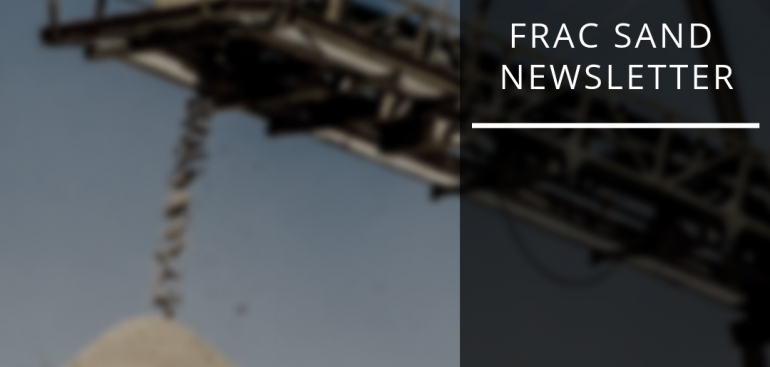You must be logged in to view this content.
The exchange saw a spike in buying activity on the back end of the week specifically for 100 mesh and 40/70. Practically every end user we spoke with has been caught short and several completion jobs were halted due to lack of proppant availability.
This week’s update is short and sweet as the market works to normalize. The FOB Odessa spot market last week settled lower at $124/ton after the weather in the northern US warmed. Early last week, rail shipments began to play catch up. It is important to remember that the sand market is not the only commodity affected by rail delays and the combination of all industries affected will likely take a couple of months to work out. The market remains very tight as supply is trying to keep up with demand. Specifically, 100 mesh is difficult to find anywhere, even with lower quality sands. The entire market seems to be sold out/over-sold on 100 mesh, which can often time be a risky position for end users. We have heard of some end users potentially switching to courser sand due to more robust availability. Weather looks to remain clear for at least the next week which should allow the catch up to continue and potentially allow prices to further back off from recent highs.
The spot market remains extremely tight this week as the rail service continued to cause the market to suffer. The FOB Odessa northern white benchmark continued its climb and was assessed at $132/ton. The exchange saw elevated activity later in the week as 100 mesh and 40/70 became available. We are seeing one buyer currently looking to lock some 100 mesh supply in for the first half of March. Basically, every single buyer we spoke with last week mentioned that they were short on 100 mesh, with some simply giving up the search by the end of the week. Tightness was not only occurring in the Permian. We also heard reports from both supply chain as well as field engineers that the DJ was practically out of courser sand and the Eagleford had dried up as well. The Permian mine set to open its doors this week will be a welcomed relief to a market desperate for supply. Supply crunches like we are experiencing right now are the exact reason the market needs a liquid spot market.
Various issues across several basins plagued the market last week. The spot market FOB Odessa benchmark continued to surge and was assessed at $120/ton. The inefficiencies of the market were once again exacerbated as more production issues occurred with two more Permian mines. At NAPE, we spoke with several operators who mentioned frac crews shutting down for the weekend due to the inability to get sand. At one point there was mention of customers trucking sand from Louisiana in order to prevent NPT. South Texas had issues of their own last week, as a plant in San Antonio shut down due to operational issues, causing stock piles to be depleted. It is noteworthy that at $120/ton and higher, we predict that demand will drop off, as many operators cease drilling due to the expense.
On Friday, the FOB Odessa spot assessment saw a strong move to the upside, ending the week at $112/ton. The move was primarily caused by a temporary shortage of Permian sand as well as a service outage on the TXN railroad (see TXN map below) caused by a fire on a bridge near Hobbs, NM. Several players were on the spot market looking to source from any available sources, however, there is not enough available northern white in-basin at the moment to satisfy nearby demand. Similar to a price spike we saw back in December, it remains to be seen if suppliers will be able to take advantage of the move higher due to the physical disruptions as well as lack of nearby spot supply. This isolated situation is a perfect example of both the need for in-basin storage as well as the ideal use scenario for PanXchange and the ability to discover spot market pricing in contingent situations.
The Permian spot market firmed a bit last week, bringing the FOB Odessa benchmark price to $103/ton, with the offers softening later in the week. We will be watching closely over the next several weeks as several Permian mines will be opening their doors and a serious fundamental shift in the market will begin to take place. (See Infill Thinking coverage) The surge in supply is exactly what we have identified as a catalyst to spark market-based transactions in the industry and will bring significant amounts of efficiency, not only to the Permian basin but to other producing basins as well. In the coming months, we will be looking to expand our benchmarking to include other important indicators, such as FOB Kermit, Monahans, and other basins.
Our assessed market benchmark (see specifications below) remains slightly lower to unchanged at $100/ton in a thinly traded market last week. In the northeast, there were a handful of end users on the spot market selling sand due to frac jobs being pushed out to deferred weeks caused by freezing weather and dangerous road conditions, especially in rural areas. In South Texas, we heard multiple reports of a class 1 railroad shutting down a major bridge for repairs, causing one supplier to be choked from their supply and causing end users to scramble to find alternate supply.


